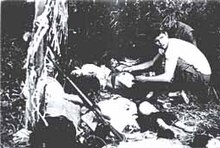Vietnam War casualties
The war also spilled over into the neighboring countries of Cambodia and Laos which also endured casualties from aerial bombing and ground fighting.
These were caused by artillery bombardments, extensive aerial bombing of North and South Vietnam, the use of firepower in military operations conducted in heavily populated areas, assassinations, massacres, and terror tactics.
[1] According to statistics from the South Vietnamese Ministry of Health, 44.5% of civilians admitted to hospitals between 1967 and 1970 were wounded by mines or mortars, 21.2% by guns or grenades, and 34.3% by artillery or bombing.
[3] A 1995 demographic study in Population and Development Review calculated 791,000–1,141,000 war-related Vietnamese deaths, both soldiers and civilians, for all of Vietnam from 1965 to 1975.
[11][12][13][14] It was difficult to distinguish between civilians and military personnel in many instances as many individuals were part-time guerrillas or impressed laborers who did not wear uniforms.
[15][16][17] Walter Mead estimates that approximately 365,000 Vietnamese civilians to have died as a result of the war during the period of American involvement.
[22] Thomas Thayer in 1985 estimated that during the 1965–72 period the VC killed 33,052 South Vietnamese village officials and civil servants.
[23] These numbers do not include civilian and State of Vietnam/ARVN military deaths resulting from the communist collectivization and land reform in North Vietnam and mass-internment, the refugee crisis and subsequent exodus of Vietnamese people after the Fall of Saigon.
[24] Benjamin Valentino estimates 110,000–310,000 deaths as a "possible case" of "counter-guerrilla mass killings" by U.S. and South Vietnamese forces during the war.
[25] Operating under the direction of the CIA and other US and South Vietnamese Intel organizations and carried out by ARVN units alongside US advisers was the Phoenix Program, intended to neutralise the VC political infrastructure, whom were the civilian administration of the Viet Cong/Provisional Revolutionary Government via infiltration, capture, counter-terrorism, interrogation, and assassination.
[28][4] Higher estimates place the number of civilian deaths caused by American bombing of North Vietnam in Operation Rolling Thunder at 182,000.
Vietnam's government claimed that 400,000 people were killed or maimed as a result of after effects, and that 500,000 children were born with birth defects.
[45] Air force captain, Brian Wilson, who carried out bomb-damage assessments in free-fire zones throughout the delta, saw the results firsthand.
[52] According to a study conducted in 1968 by a Quaker-funded Vietnamese-speaking American couple, Diane and Michael Jones, there were at least 12 mass killings committed by South Korean forces that approached the scale of the My Lai Massacre, with reports of thousands of routine murders of civilians, primarily the elderly, women and children.
[53][54] A separate study was carried out by RAND Corporation employee Terry Rambo, who conducted interviews in 1970 on reported Korean atrocities in ARVN/civilian areas.
Accurate assessments of PAVN/VC losses, he wrote, were 'largely impossible due to lack of disclosure by the Vietnamese government, terrain, destruction of remains by firepower, and [inability] to confirm artillery and aerial kills.'
For this figure, Guenter Lewy assumes that one-third of the reported enemy killed may have been civilians, concluding that the actual number of deaths of the VC and PAVN military forces was probably closer to 444,000.
[73][74] Historian Christian Appy states "search and destroy was the principal tactic; and the enemy body count was the primary measure of progress" in the US strategy of attrition.
[75] Other casualties The PAVN/VC forces suffered around 600,000 wounded during the war,[76] and prior to the 1975 spring offensive, lost at least 26,880 soldiers taken prisoner - being released after the 1973 Peace Accords.
[77] Additionally, according to the U.S. military, they also lost up to 101,511 personnel as defectors due to the Chieu Hoi program,[78] but one analyst speculates that less than 25% of those were genuine.
[100][101] With the draft increasing due to the troop buildup in South Vietnam, the military significantly lowered its admission standards.
In October 1966, Defense Secretary Robert McNamara initiated Project 100,000 which further lowered military standards for 100,000 additional draftees per year.
[100][104] Civil rights leaders, including Martin Luther King Jr., Malcolm X, John Lewis, Muhammad Ali and others, criticized the racial disparity in both casualties and representation in the entire military, prompting the Pentagon to order cutbacks in the number of African Americans in combat positions.
Commander George L. Jackson said, "In response to this criticism, the Department of Defense took steps to readjust force levels in order to achieve an equitable proportion and employment of Negroes in Vietnam."
The Army instigated myriad reforms, addressed issues of discrimination and prejudice from the post exchanges to the lack of black officers, and introduced "Mandatory Watch And Action Committees" into each unit.
[106][107] In 2012 alone, unexploded ordnance had claimed 500 casualties in Vietnam, Laos and Cambodia, according to activists and Vietnamese government databases.
[108] Agent Orange and similar chemical defoliants have also caused a considerable number of deaths and injuries over the years, including among the US Air Force crew that handled them.
[109] The Red Cross of Vietnam estimates that up to 1 million people are disabled or suffer health problems due to Agent Orange exposure.
The Vietnamese newspaper Nhân Dân reported in 2012 that the U.S. government was providing $41 million to the project, which aimed to reduce the contamination level in 73,000 m3 of soil by late 2016.
The boat people's first destinations were the Southeast Asian locations of Hong Kong, Indonesia, Malaysia, Philippines, Singapore, and Thailand.





